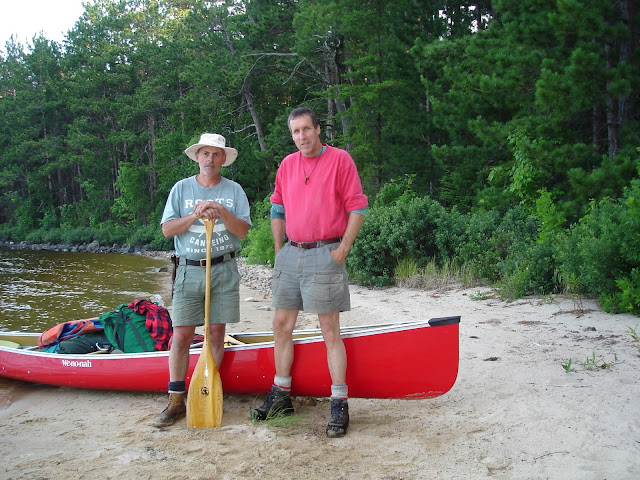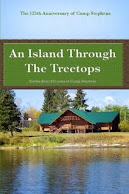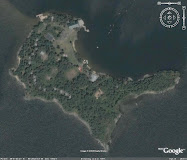Have you ever tried to hitch hike on the
TransCanada Highway with a canoe?
That’s how this story ends. . .
It begins in the late summer of
1972, when Camp Stephens canoe trip counsellors Rick Prior, Brad Abbott and Bob
McColm headed out to scout a new canoe route for the Voyageur program.
 |
| Rick Prior just after being given the ceremonial dunking at the end of one of his trips as the canoe trip leader. |
Forty-four years later, some of the
details of the trip are a bit vague, but some were so unusual that they are
unforgettable.
None of us can remember whether we were
assigned the trip route or we planned it ourselves; we were just grateful to
have the opportunity to explore new territory.
It was a great way to finish off
the summer. The journey started in Winnipeg and the drop-off point was approximately
70 kilometres up the Confederation Lake Road north east of Ear Falls. The road provided
access to the Uchi mine and not much else, as forestry operations had not
progressed this far north in the early 70s.
The route was an ambitious seven-day trip with some lake
travel at the beginning, small creek systems in the middle and a return run to
Ear Falls down the Wenasaga River system. The mapped route was 220 km with 36
portages.
As we passed through Ear Falls we stopped
at the Lands and Forest Ranger Station hoping that the forestry staff could
offer a bit more information about the intended route, but no additional
insight was gained. Our route was
planned on a 1:250,000 topographic map (1 inch equals 4 miles) and an Alex
Wilson Red Lake Area Vacation Map at the same scale. The route appeared feasible based on the portages that were indicated
on the Alex Wilson map. Copies of
the route were left at the camp; this was the only record of where we were
going and where we were to be picked up seven days later.
The Day 1 route took us north up Confederation
Lake, through Washagomis Lake and into Swain Lake where we stopped briefly at
Swain Post. It was a modest cabin
that served as a trading post and provisions depot for trappers and prospectors
who worked the area. Our memories are faint and we recall very little about any
conversation we may have had with the operator.
We crossed the portage into Shabumeni Lake and camped at the
first suitable site, a bit short of our intended stopping point. The next day we
needed to make up the 8 km shortfall. We went up Shabumeni Lake and the
Shabumeni River and a short portage put us on Birch Lake. After paddling
eastward on Birch Lake we passed through Sutterly Lake and late in the
afternoon after paddling about 43 km, we started up a narrow winding creek
headed toward our Night 2 destination of Bertha Lake, only 4 km further on.
Progressing up the creek we began to
encounter numerous spruce deadfalls that were suspended from shore to shore. It was nearly impossible to pass under
them and the banks were clogged with brush and branches; there was no obvious
portage around this jackpot.
We
chopped through many trees and squeezed under others, only to go around another
bend to find more. As we inched along we failed to notice the sun was beginning
to set as the days at the end of August are much shorter. It was clear we would not make it to
Bertha Lake before nightfall and it was too late to back out of “shits” creek
to Sutterly Lake so Night 2 was spent camped in a black spruce, tamarack swamp.
We set up the tent on the moss hummocks
which felt like a water bed when we finally settled in for the night. Exhausted
we had a bit of trail lunch for dinner but went to bed mighty thirsty as we had
no drinkable water in the swamp.
The next morning we had to make a decision;
backtrack or press on, not knowing if the narrow creek would eventually become
passible, and not knowing if the other creeks further along the planned route
would be equally problematic. If our progress was further impeded we would not
complete the route in time to be picked up as scheduled, and we had no means to
communicate that we would be delayed.
We examined the maps closely; there were a lot of single line creeks on
the map between us and the Wenesaga River and no way of knowing how much
difficulty we might have if we pushed on.
We did know we would be at least one day, maybe too days late coming
out.
Reluctantly, we decided to
backtrack as we did not want to cause worry and uncertainty if we did not
arrive at the pickup point on schedule.
After backing out of the creek and retreating to Sutterly Lake we
discovered a trapper’s log cabin and stopped to cook breakfast at the cabin
site. The cabin looked like it
belonged to Jeremiah Johnson with trapping gear hanging on spikes and when we
peered in the windows you could see blankets hanging from the rafters and cook
wear piled on a small table.
We
did not try to enter the cabin as we did not want to trespass, but we did leave
the site wondering who the trapper was, and what it would be like to be in this
remote location in the dead of winter.
 |
| Bob and Brad - TL for dinner before night in the swamp |
 |
| Rick and Bob at Trapper’s cabin |
We examined our maps and plotted a new
route that would take us back to Swain Lake through a series of small lakes and
portages just north of Grace Lake. Early one morning we were headed west
passing through one of the unnamed lakes.
We were paddling close to shore when Rick
in the stern called for paddling to stop as he had seen something just inside
the shoreline reflect the sun. We
turned around, paddled back but could not see anything. After being certain we
had gone back far enough we turned around again and paddled very slowly hugging
the shore.
We spotted the reflection a second time, pulled over to shore,
landed and walking in a short distance to discover a grave site. There was a wooden cross about five feet
tall, and in the centre of the cross was a piece of tin with an
inscription. The inscription was
created by a series of carefully placed tiny nail holes.
We took a picture of the cross and
recall copying down the inscription in our trip note book, but the notes are
now long lost and the photograph is blurred. The name on the cross was however unforgettable because of
its uniqueness; it was the grave of Ephraim Bergstrand.
 |
| Ephraim Bergstrand grave |
Often when you are off in the
wilderness, you allow yourself to think that you are the first person to ever
set foot in that location…and then you find an old rusty bean can…but rarely a
grave.
After passing Swain Post,
and the trapper’s cabin and now discovering a grave, it caused us to wonder who
these people were and what brought them to this remote area many years before.
Who was Ephraim Bergstrand? How did he
die and why was he buried on the shore of this small unnamed lake? Perhaps the old mining relics we passed
later in the day were a clue?
We resumed our journey, now at a leisurely
pace. We would have no trouble
getting to our pickup location on schedule as we had no creeks to contend with,
just lake travel. We were now likely to be at our pick up point a day early as
opposed to one or two days late. We crossed one portage (not sure which one) that
was a narrow foot path bordered by lush green moss as far as you could see.
 |
| Brad and Rick on the “mossy” portage |
The “green” was so noticeable that it caught
the attention of three 19 year old guys, when we paused for a short
break…so it must have been exceptional.
On Day 5 we traveled south down Woman Lake to Woman River and
then back to Confederation Lake. Apart for meeting the operator at Swain Post,
we did not see any other person on the entire trip.
None of us recall much about the other
portages or our campsites on the trip, but our last night made up for the night
in the swamp. We were camped on a rocky point with a flat smooth slab of bedrock.
Although we set up the Marsan tent we
decided we would sleep under the stars as it was shaping up to be a clear,
cool, bug-free night. Drinking tea
around the campfire, Rick threw out a wild suggestion.
Rather than spending the next day as a
layover day waiting for our pickup, maybe we should try to hitch hike back to
Camp Stephens! Truth be known, we
did have a concern that we would face ridicule for not completing our planned
route but perhaps returning to camp by hitch hiking would become the focus of
the story.
We decided to go for it
and then settled in for the night, on the rock, under the stars. We were rewarded by a spectacular show
of shooting stars followed by northern lights. The light show was great…the sleep on the rock not so much!
 |
| Brad prior to our night under the stars and northern lights |
We got an early start the next morning and
made it back to the Uchi mine gate on the Confederation Lake Road…and started
“hitch hiking”; three guys, a couple of Woods No.1 Special packs and a Langford
canoe.
After a short wait, an
equipment salesman in a car stopped and asked what we were up to. He said he would gladly offer us a ride
but the canoe was a problem. Along
came an ore truck headed to the Ear Falls rail siding. The driver was willing
to take the canoe in the back of the truck; one of us rode with him and the
other two went with the salesman.
We unloaded at the railway siding just
outside of Ear Falls where we met a railway foreman who offered to drive us to the
Ear Falls dam. At the time there
was a single traffic lane over the dam controlled by a traffic light. This provided a captive audience of
stopped traffic that allowed us to attempt to negotiate (a.k.a. beg) a
ride. After a couple of hours a
young guy and his dog in a VW microbus from Nova Scotia offered to take us down
the Red Lake Road. We loaded up,
climbed in the van and he welcomed us with three cold beers…best beer we ever
had.
Our Nova Scotia friend dropped us off in
Vermillion Bay at the junction of the Red Lake Road and the TransCanada
highway. So there we were…hitch hiking on the TransCanada highway; three smoky,
sweaty, grubby guys, packs, paddles and a bright red Langford canoe, that was
impossible to hide in the ditch.
We were there for several hours and endured numerous sarcastic remarks
from passersby. It looked like we might get stuck there and would have to call
the camp to advise them of our whereabouts.
Eventually, just before sunset, a
fellow offered us a ride to Kenora in his pickup truck; two of us in the back
holding the canoe and one lucky guy in the warm cab. Well after dark we were dropped off at Fisherman’s Dock and then
we night paddled through Devil’s Gap and down the lake to Camp Stephens
arriving about 2:00 am. We met our
objective which was to arrive at camp before the driver set out in the morning
to pick us up at the Uchi mine.
We proudly laid claim to the record for the
“longest portage” (approx. 230 km). It was now in the CS record book…and best
of all, we faced no ridicule for not completing our planned route.
A week later Rick and Bob were headed to
Lakehead University for first year field camp in the Forestry program. About a
month later they were introduced to aerial photography and the forestry maps
that were in use at the time across the province. The aerial photography was at a scale of four inches equals one mile;
16 times more resolution than the maps we used on our trip. Had we known at the
time, the route could have been planned using these photographs and all
uncertainty about the route would have been eliminated.
Today, there are other tools that make
wilderness trip planning more predictable and safer. Examination of Google
Earth imagery now reveals that the route was doable and had we pushed through
the difficult stretch of creek to Bertha Lake, we probably would have been ok
for the rest of the planned route, although still probably a day late.
The imagery also shows that we had
other route options in the area (Seagrave Lake to Deaddog Lake to Marsh Lake) that
likely would have been a preferred route, but these lakes were just off the
edge of our Alex Wilson map. It also shows that a large forest fire started
east of Grace Lake and burned eastward over the area north of Bertha Lake and
the clogged creek that forced us to turn back.
Today we have GPS technology, satellite
phones and SPOT beacons which provide communication capability and the means to
deal with safety predicaments or delays with pick up arrangements.
There are a number of remote tourism
outpost camps on the lakes in the area which also provide a way to deal with
emergency situations. Trip leaders
of today, should certainly make use of these modern tools, but keep them tucked
away in the bottom of the leader’s pack and only used for emergencies. It is still possible to preserve the
adventurous spirit of a trip in the “boonies” by navigating using the old topo
maps.
So who was Ephraim Bergstrand? We had no way of finding out back in
1972, but today a few hours on the
internet reveal that he was a prospector back in the 1930s. His name appears in
a couple of 1936 provincial mining reports and one document reports that he
recovered “a few ounces of gold by hand crushing and panning” on his mining
claims in the vicinity of “Bergstrand Lake”.
This lake name does not appear on any of today’s maps, but a
1936 Ontario Geological Survey map (P.3118) map was discovered that shows Bergstrand
Lake; it was one of the small unnamed lakes we travelled through, and likely
the site of his grave. Another intranet site that provides detailed mapping of
the position of the sun at any location, year, date and time confirms that the
sun’s rays would have hit the south shores of the two un-named lakes early in
the morning in late August 1972.
Forestry operations have not yet reached
this area, but they are now not too far to the south. So the mossy portage, the
trapper’s cabin and Bergstrand’s grave have not been affected by
development. Forest companies are
very diligent at protecting known values when planning and carrying out timber
harvesting operations.
So, the closing chapter to this story will be a
commitment to inform the forestry company of our discovery 44 years ago, and
ask that they make their best efforts to locate the Bergstrand grave, likely on
the shore of Bergstrand Lake, and leave it undisturbed when they operate in the
area sometime in the future. R.I.P.
Mr. Bergstrand.
 |
| Rick Prior and Bob McColm on a canoe trip in Quetico Park in 2006. We were not quite as lean and mean as in 1972, but could still smoke past any other paddlers that we met during the trip! |
A footnote to the story: Rick Prior and Bob
McColm have remained good friends over the years and continued canoe tripping.
Rick’s home is Thunder Bay, and Bob moved from Dryden to Peterborough in 2009.
Brad Abbott’s home is now Toronto and we tracked him down with some internet
sleuthing. Memories of the 1972 trip have faded, as have the photographs, but
the memorable aspects of this trip and our time at Camp Stephens will never be
forgotten.
Rick Prior
Brad Abbott
Bob McColm
June 2016









